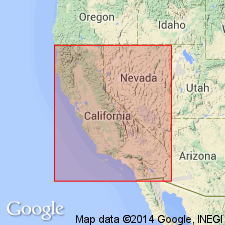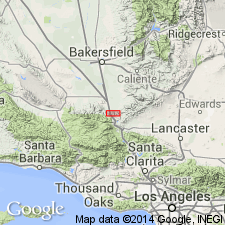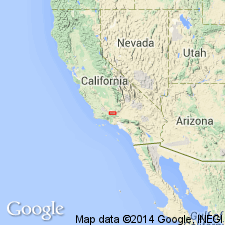
- Usage in publication:
-
- Tecuya beds
- Modifications:
-
- Named
- Biostratigraphic dating
- Dominant lithology:
-
- Sandstone
- Shale
- Lava
- Tuff
- AAPG geologic province:
-
- Transverse Ranges province
Summary:
Unit is named the Tecuja [note spelling] beds. Consists of red colored sandstones and shales; also includes tuffs and lavas. Conglomerates are also present in several horizons. Age is [Oligocene or Miocene].
Source: GNU records (USGS DDS-6; Menlo GNULEX).

- Usage in publication:
-
- Tecuya formation
- Modifications:
-
- Revised
- AAPG geologic province:
-
- Transverse Ranges province
Summary:
Tecuja beds of Stock (1920) is used here as a formational name. Age is Oligocene(?) [figure 233].
Source: GNU records (USGS DDS-6; Menlo GNULEX).

- Usage in publication:
-
- Tecuya Formation*
- Modifications:
-
- Adopted
- Geochronologic dating
- AAPG geologic province:
-
- Transverse Ranges province
Summary:
Tecuja beds of Stock (1920) and Tecuya formation of Marks (1943) is adopted as the Tecuya Formation. Is informally divided into a lower unit consisting of interbedded conglomerates, sandstones, and mudstones, with local breccias in the lower part; a volcanic unit consisting of black fine-grained ophitic basalt and some scoriaceous basalt and pinkish-brown-weathering blue-gray dacite; and an upper unit consisting of crudely interbedded red, green buff, and blue-gray cobble and pebble conglomerates, sandstones, and mudstones. Thickness of type section is approximately 2,350 ft. [Conformably] overlies the Tejon Formation; conformably underlies and interfingers with the Temblor Formation. Age is Eocene(?) to Miocene based on isotopic dates of 22.3 +/-0.7 Ma to 21.5 +/-0.7 Ma from the volcanic unit and from fossils [foraminifers, mollusks] and stratigraphic relations.
Source: GNU records (USGS DDS-6; Menlo GNULEX).
For more information, please contact Nancy Stamm, Geologic Names Committee Secretary.
Asterisk (*) indicates published by U.S. Geological Survey authors.
"No current usage" (†) implies that a name has been abandoned or has fallen into disuse. Former usage and, if known, replacement name given in parentheses ( ).
Slash (/) indicates name conflicts with nomenclatural guidelines (CSN, 1933; ACSN, 1961, 1970; NACSN, 1983, 2005, 2021). May be explained within brackets ([ ]).

